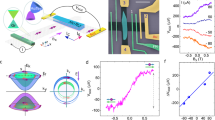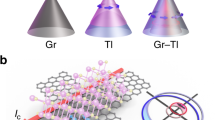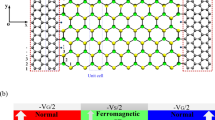Abstract
Spin information processing is a possible new paradigm for post-CMOS (complementary metal-oxide semiconductor) electronics and efficient spin propagation over long distances is fundamental to this vision. However, despite several decades of intense research, a suitable platform is still wanting. We report here on highly efficient spin transport in two-terminal polarizer/analyser devices based on high-mobility epitaxial graphene grown on silicon carbide. Taking advantage of high-impedance injecting/detecting tunnel junctions, we show spin transport efficiencies up to 75%, spin signals in the mega-ohm range and spin diffusion lengths exceeding 100 μm. This enables spintronics in complex structures: devices and network architectures relying on spin information processing, well beyond present spintronics applications, can now be foreseen.
This is a preview of subscription content, access via your institution
Access options
Subscribe to this journal
Receive 12 print issues and online access
$209.00 per year
only $17.42 per issue
Buy this article
- Purchase on Springer Link
- Instant access to full article PDF
Prices may be subject to local taxes which are calculated during checkout




Similar content being viewed by others
References
Datta, S. & Das, B. Electronic analog of the electro-optic modulator. Appl. Phys. Lett. 56, 665–667 (1990).
Hall, K. C. & Flatté, M. E. Performance of a spin-based insulated gate field effect transistor. Appl. Phys. Lett. 88, 162503 (2006).
Dery, H., Cywinski, L., Dalal, P. & Sham, L. J. Spin-based logic in semiconductors for reconfigurable large scale circuits. Nature 447, 573–576 (2007).
Behin-Aein, B., Datta, D., Salahuddin, S. & Datta, S. Proposal for an all-spin logic device with built-in memory. Nature Nanotech. 5, 266–270 (2010).
Jedema, F. J., Heersche, H. B., Filip, A. T., Baselmans, J. J. A. & van Wees, B. J. Electrical detection of spin precession in a metallic mesoscopic spin valve. Nature 416, 713–716 (2002).
Dash, S. P., Sharma, S., Patel, R. S., de Jong, M. P. & Jansen, R. Electrical creation of spin polarization in silicon at room temperature. Nature 462, 491–494 (2009).
Lou, X. et al. Electrical detection of spin transport in lateral ferromagnet–semiconductor devices. Nature Phys. 3, 197–202 (2007).
Van’t Erve, O. M. J. et al. Electrical injection and detection of spin-polarized carriers in silicon in a lateral transport geometry. Appl. Phys. Lett. 91, 212109 (2007).
Rashba, E. Theory of electrical spin injection: Tunnel contacts as a solution of the conductivity mismatch problem. Phys. Rev. B 62, R16267–R16270 (2000).
Fert, A. & Jaffrès, H. Conditions for efficient spin injection from a ferromagnetic metal into a semiconductor. Phys. Rev. B 64, 184420 (2001).
Fert, A., George, J-M., Jaffres, H. & Mattana, R. Semiconductors between spin-polarized sources and drains. IEEE Trans. Electron Dev. 54, 921–932 (2007).
Huertas-Hernando, D., Guinea, F. & Brataas, A. Spin-orbit coupling in curved graphene, fullerenes, nanotubes, and nanotube caps. Phys. Rev. B 74, 155426 (2006).
Hueso, L. E. et al. Transformation of spin information into large electrical signals using carbon nanotubes. Nature 445, 410–413 (2007).
Hill, E. W., Geim, A. K., Novoselov, K., Schedin, F. & Blake, P. Graphene spin valve devices. IEEE Trans. Magn. 42, 2694–2696 (2006).
Tombros, N., Jozsa, C., Popinciuc, M., Jonkman, H. T. & van Wees, B. J. Electronic spin transport and spin precession in single graphene layers at room temperature. Nature 448, 571–574 (2007).
Wang, W. H. et al. Magnetotransport properties of mesoscopic graphite spin valves. Phys. Rev. B 77, 020402 (2008).
Ohishi, M. et al. Spin injection into a graphene thin film at room temperature. Jpn. J. Appl. Phys. 46, 605–607 (2007).
Goto, H. et al. Gate control of spin transport in multilayer graphene. Appl. Phys. Lett. 92, 212110 (2008).
Han, W. et al. Tunneling spin injection into single layer graphene. Phys. Rev. Lett. 105, 167202 (2010).
De Heer, W. A. et al. Large area and structured epitaxial graphene produced by confinement controlled sublimation of silicon carbide. Proc. Natl Acad. Sci. USA 108, 16900–16905 (2011).
Berger, C. et al. Electronic confinement and coherence in patterned epitaxial graphene. Science 312, 1191–1196 (2006).
Sprinkle, M. et al. First direct observation of a nearly ideal graphene band structure. Phys. Rev. Lett. 103, 226803 (2009).
Hass, J. et al. Why multilayer graphene on 4H-SiC(000 ) behaves like a single sheet of graphene. Phys. Rev. Lett. 100, 125504 (2008).
Takahashi, S. & Maekawa, S. Spin currents in metals and superconductors. J. Phys. Soc. Jpn 77, 031009 (2008).
Jaffrès, H., George, J-M. & Fert, A. Spin transport in multiterminal devices: Large spin signals in devices with confined geometry. Phys. Rev. B 82, 140108 (2010).
Žutić, I., Fabian, J. & Das Sarma, S. Spintronics: Fundamentals and applications. Rev. Mod. Phys. 76, 323–410 (2004).
Barraud, C. et al. Magnetoresistance in magnetic tunnel junctions grown on flexible organic substrates. Appl. Phys. Lett. 96, 072502 (2010).
Józsa, C. et al. Linear scaling between momentum and spin scattering in graphene. Phys. Rev. B 80, 241403 (2009).
Fukuma, Y. et al. Giant enhancement of spin accumulation and long-distance spin precession in metallic lateral spin valves. Nature Mater. 10, 527–531 (2011).
Dash, S. P. et al. Spin precession and inverted Hanle effect in a semiconductor near a finite-roughness ferromagnetic interface. Phys. Rev. B 84, 054410 (2011).
Locatelli, A. et al. Corrugation in exfoliated graphene: an electron microscopy and diffraction study. ACS Nano 4, 4879–4889 (2010).
Hiebel, F., Mallet, P., Magaud, L. & Veuillen, J-Y. Atomic and electronic structure of monolayer graphene on 6H-SiC(000 ) (3×3): A scanning tunneling microscopy study. Phys. Rev. B 80, 235429 (2009).
Dlubak, B. et al. Are Al2O3 and MgO tunnel barriers suitable for spin injection in graphene? Appl. Phys. Lett. 97, 092502 (2010).
Ikeda, S. et al. Tunnel magnetoresistance of 604% at 300 K by suppression of Ta diffusion in CoFeB/MgO/CoFeB pseudo-spin-valves annealed at high temperature. Appl. Phys. Lett. 93, 082508 (2008).
Acknowledgements
We thank H. Jaffrès for helpful discussions. This research was partially supported by the W M Keck Foundation and the NSF under Grant No DMR-0820382. This research was partially supported by the EU FP7 work programme under grant GRAFOL. P.S. wants to acknowledge the Institut Universitaire de France for junior fellowship support.
Author information
Authors and Affiliations
Contributions
B.D., M-B.M. A.A. and P.S. carried out the whole project, including planning, experimental work, data analysis and writing of the paper. R.M., F.P. and A.F. also discussed the results. A.F. also participated in writing of the paper. C.D., B.S. and S.X. contributed to sample fabrication and characterization. M.S., C.B. and W.A.D.H. grew and characterized the epitaxial graphene layers. All authors participated in general discussions and commented on the manuscript.
Corresponding author
Ethics declarations
Competing interests
The authors declare no competing financial interests.
Rights and permissions
About this article
Cite this article
Dlubak, B., Martin, MB., Deranlot, C. et al. Highly efficient spin transport in epitaxial graphene on SiC. Nature Phys 8, 557–561 (2012). https://doi.org/10.1038/nphys2331
Received:
Accepted:
Published:
Issue Date:
DOI: https://doi.org/10.1038/nphys2331
This article is cited by
-
An epitaxial graphene platform for zero-energy edge state nanoelectronics
Nature Communications (2022)
-
Recent Advances in Two-Dimensional Spintronics
Nanoscale Research Letters (2020)
-
Synthesis and characterization of WS2/graphene/SiC van der Waals heterostructures via WO3−x thin film sulfurization
Scientific Reports (2020)
-
2D materials for spintronic devices
npj 2D Materials and Applications (2020)
-
Spintronics in Two-Dimensional Materials
Nano-Micro Letters (2020)



